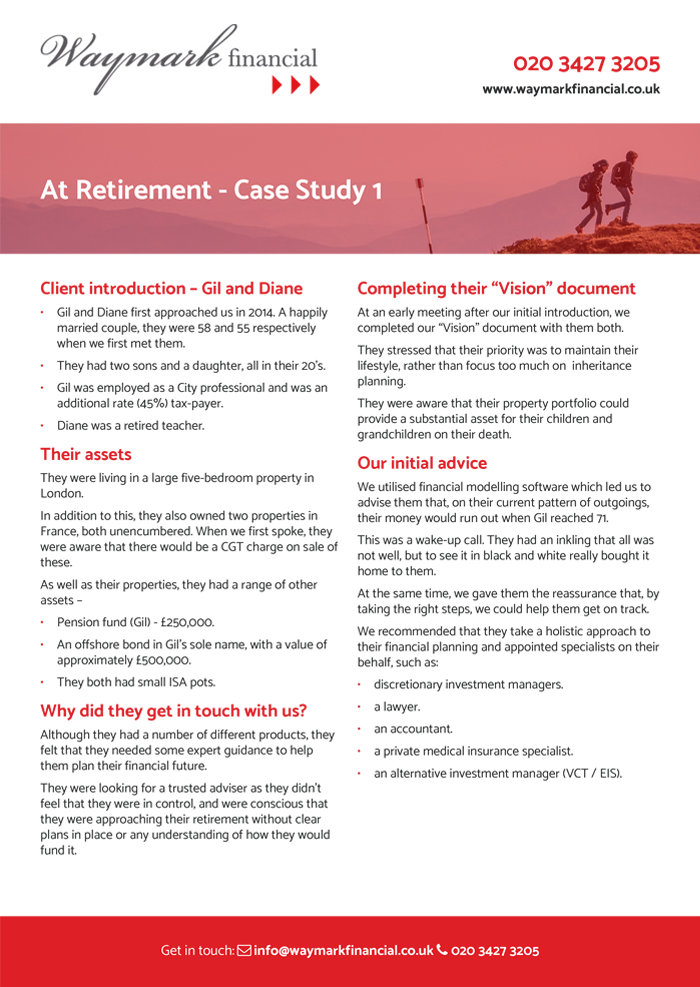Client introduction – Gil and Diane
- Gil and Diane first approached us in 2014. A happily married couple, they were 58 and 55 respectively when we first met them.
- They had two sons and a daughter, all in their 20’s.
- Gil was employed as a City professional and was an additional rate (45%) tax-payer.
- Diane was a retired teacher.
Their assets
They were living in a large five-bedroom property in London.
In addition to this, they also owned two properties in France, both unencumbered. When we first spoke, they were aware that there would be a CGT charge on sale of these.
As well as their properties, they had a range of other assets –
- Pension fund (Gil) – £250,000.
- An offshore bond in Gil’s sole name, with a value of approximately £500,000.
- They both had small ISA pots.
Why did they get in touch with us?
Although they had a number of different products, they felt that they needed some expert guidance to help them plan their financial future.
They were looking for a trusted adviser as they didn’t feel that they were in control, and were conscious that they were approaching their retirement without clear plans in place or any understanding of how they would fund it.
Completing their “Vision” document
At an early meeting after our initial introduction, we completed our “Vision” document with them both.
They stressed that their priority was to maintain their lifestyle, rather than focus too much on inheritance planning.
They were aware that their property portfolio could provide a substantial asset for their children and grandchildren on their death.
Our initial advice
We utilised financial modelling software which led us to advise them that, on their current pattern of outgoings, their money would run out when Gil reached 71.
This was a wake-up call. They had an inkling that all was not well, but to see it in black and white really bought it home to them.
At the same time, we gave them the reassurance that, by taking the right steps, we could help them get on track.
We recommended that they take a holistic approach to their financial planning and appointed specialists on their behalf, such as:
- discretionary investment managers.
- a lawyer.
- an accountant.
- a private medical insurance specialist.
- an alternative investment manager (VCT / EIS).
As part of the advice the offshore bond was assigned to Diane (straddling tax years), which saved a substantial amount in tax, because she was a non-taxpayer. This enabled them to take annual sums in a tax-efficient manner.
They also started paying into a pension for Diane, to take advantage of her pension allowance and give her some financial independence.
The decision to downsize
Based on the output of the financial modelling, downsizing their property became a key focus to help them achieve their lifestyle.
They started this process in 2019, buying a smaller property with far less overheads. The renovation lasted until October 2021 when they finally moved in. In between times, they rented a property.
This downsizing reduced their monthly outgoings by 30% and released capital of £500,000. Some of this was used to renovate the new property, make ISA and pension contributions and to provide a cash “larder”.
Ongoing advice
We meet annually with Gil and Diane.
At each meeting we review their plans, discuss any changes in circumstances and update the financial model based on current information.
The latest forecast suggests that their current lifestyle will be sustainable, based on the capital they have released, until Gil is 95.
Key learnings from this case study
- It’s essential to have a plan in place when it comes to looking ahead to your retirement.
- Modelling your financial future using a financial modelling forecasting tool can make a big difference to your financial planning. It can tell you if you’re on track to achieve your goals or make changes in the way you’re managing your money or how you’re invested. As we’ve seen in this case study, without the insight provided by our financial modelling forecast, Gil and Diane could have been in an awkward position, financially if they hadn’t taken the decision to downsize.
- A successful and happy future doesn’t happen by accident. There’s a good deal of planning involved – both initially, and then on a regular basis to ensure you stay on track.

